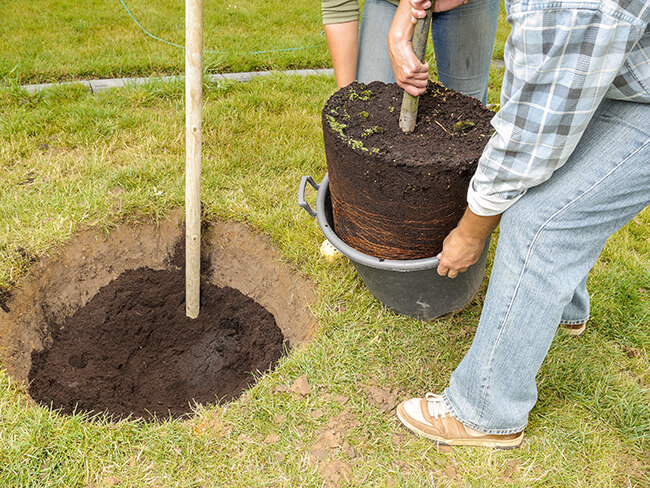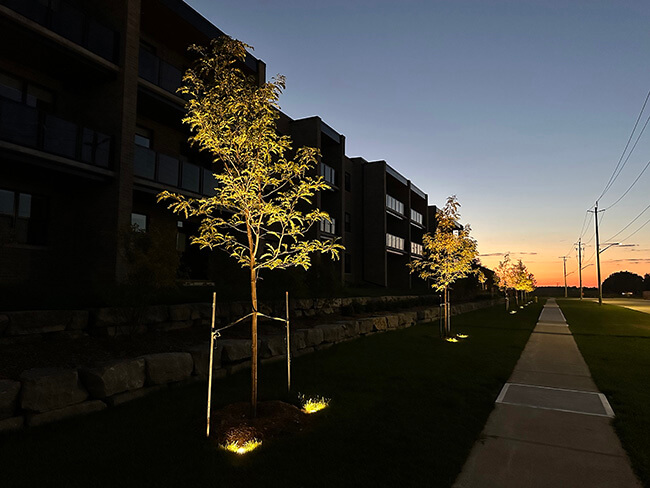Planting or transplanting a tree is a significant step towards enhancing your landscape, but the success of this endeavour largely depends on the care provided during the first few years. This comprehensive guide will help ensure your newly planted or transplanted tree thrives.
Watering Newly Planted Trees
 Initial Watering: Immediately after planting or transplanting, water the tree thoroughly. This helps settle the soil and eliminate air pockets around the roots.
Initial Watering: Immediately after planting or transplanting, water the tree thoroughly. This helps settle the soil and eliminate air pockets around the roots.- Establishing a Routine: For the first few weeks, water the tree every 2-3 days. Gradually reduce the frequency to once a week after the tree has started to establish itself (about 6-8 weeks).
- Water Quantity: Ensure deep watering, which means the water should reach the tree’s root zone (about 12-18 inches deep). Depending on the size of the tree, 10-15 gallons of water per watering session may be needed.
- Mulching: Apply a 2-4 inch layer of mulch around the base of the tree, keeping it a few inches away from the trunk. Mulch helps retain moisture and regulates soil temperature.
Fertilizing Newly Planted Trees
 When to Fertilize: Avoid fertilizing immediately after planting. Wait until the tree shows signs of new growth, which indicates it has begun to establish its roots.
When to Fertilize: Avoid fertilizing immediately after planting. Wait until the tree shows signs of new growth, which indicates it has begun to establish its roots.- Type of Fertilizer: We prefer fertilizer spikes which are balanced and slow-release, and are inserted into the soil around the drip line, which eliminates risk of burning the grass surrounding the tree. Organic compost or well-decomposed manure can also be beneficial.
- How to Apply: Stake about 4 fertilizer spikes, evenly spaced, in the soil under the tree canopy.
Protection from Wind
 Staking: Young trees may need to be staked to protect them from strong winds, especially in exposed areas. Use flexible tree ties that allow some movement, promoting a stronger trunk.
Staking: Young trees may need to be staked to protect them from strong winds, especially in exposed areas. Use flexible tree ties that allow some movement, promoting a stronger trunk.- Placement of Stakes: Smaller trees typically only require one stake. Place stake outside the root ball, angled outward, on the side of prevailing winds and tie the tree loosely. If staking a larger tree, add a second stake opposite the first one. Remove stakes after one growing season to prevent girdling and to encourage independent growth.
Protection from Standing Water
While improving drainage by amending the soil and/or raising the planting site can improve the immediate area, it will not help the tree in the long run. Once the tree is established and the roots grow beyond the amended area, they’ll be exposed to the poor draining characteristics of the overall site. It’s best to avoid areas with poor drainage, and opt instead for spots with more tree-friendly soil conditions.
Protection from Frost and Snow
 Frost Protection: In areas prone to frost, new evergreens should be wrapped with burlap, but this is only necessary for their first winter. Young deciduous trees do not need to be wrapped unless they are not extremely hardy for your zone.
Frost Protection: In areas prone to frost, new evergreens should be wrapped with burlap, but this is only necessary for their first winter. Young deciduous trees do not need to be wrapped unless they are not extremely hardy for your zone.- Mulching for Insulation: Mulch not only retains moisture but also insulates the roots from extreme cold. Apply mulch before the first hard freeze and replenish as needed throughout the winter.
- Snow and Ice Removal: Gently brush off snow from the branches to prevent them from breaking. Avoid using salt-based deicers near trees, as salt can damage the roots and soil structure.
Monitoring and Maintenance
- Regular Inspections: Check the tree regularly for signs of stress, such as wilting, discoloration, or pests. Address any issues promptly to prevent long-term damage.
- Pruning: Prune any dead, damaged, or diseased branches to promote healthy growth. Avoid heavy pruning in the first year after planting to allow the tree to establish itself.
- Pest and Disease Control: Monitor for pests and diseases, and treat as necessary. Organic and biological controls should be used according to the severity of the problem and the tree species. Chemical pest controls are not permitted for use in Ontario.
Caring for Newly Planted Trees Long Term
- Ongoing Watering and Fertilization: Continue to water the tree during dry spells, even after it has become established. Fertilize annually, for the first five years. After that, roots are so deep that standard fertilization strategies will not impact the deep roots. If you do suspect that your tree requires fertilization, we recommend contacting a company that specializes in deep root fertilization.
- Seasonal Adjustments: Adapt your care routine to seasonal changes. For example, reduce watering in the fall as the tree prepares for dormancy, and resume regular watering in the spring.
Proper care during the first few years of a tree’s life sets the foundation for a healthy, long-lasting addition to your landscape. By following these guidelines, you can ensure your tree grows strong and resilient, contributing to the beauty and health of your environment for years to come. If you’d prefer to have assistance with tree selection and planting, contact us.

